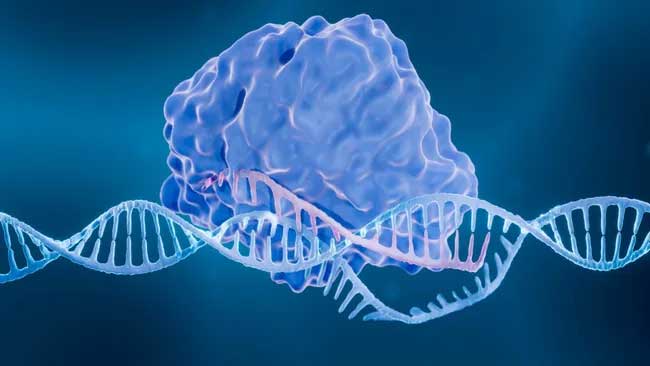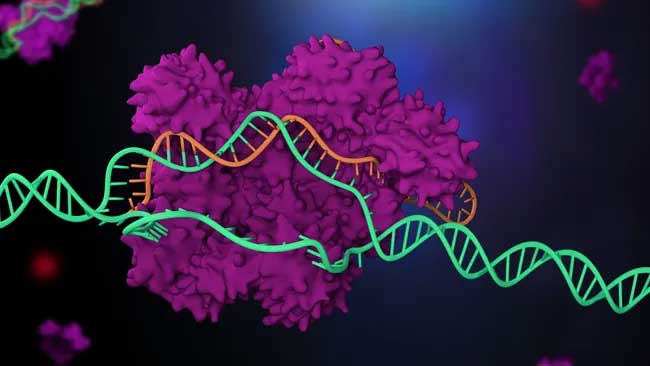Preliminary data from a groundbreaking clinical trial suggests that CRISPR could be safely used in cancer therapy. In the first clinical trial of its kind, researchers used the gene-editing tool CRISPR to fine-tune the DNA of people’s immune cells in hopes of fighting cancer.
Preliminary study data show that the technique is safe for use in cancer patients.
“This is proof that we can safely do gene editing in these cells,” study co-author Dr. Edward Stadtmauer, a professor of oncology at the University of Pennsylvania, told The Associated Press in 2019.
Still, “this treatment is not ready for widespread use yet,” Stadtmauer added in an interview with NPR. “But it’s definitely very promising.”
At the time, only three patients had received the pioneering therapy — two with a blood cancer called multiple myeloma and one with sarcoma, a cancer of connective tissue, according to a statement from the University of Pennsylvania. The researchers were able to safely remove, edit, and return cells to the patients’ bodies. Safety was measured in terms of side effects, and the authors found that there were no serious side effects from the treatment.
According to the American Cancer Society, a Phase I clinical trial like this typically involves only a few patients. The small study aims to determine how the body responds to the new drug and whether patients experience any adverse reactions. Phase I trials do not address whether the drug actually helps treat the disease — that question comes up in later trials. The CRISPR study currently suggests the new cancer therapy is safe for at least three people, until more data is available.

“I’m just so excited about this,” Jennifer Doudna, a biochemist at the University of California, Berkeley, whose team first discovered and developed CRISPR technology, told NPR. (Doudna was not involved in the current study.)
CRISPR allows scientists to cut specific pieces of DNA from a cell’s genetic code and insert new ones if needed. Stadtmauer and his colleagues applied the technique to T cells, a type of white blood cell that attacks diseased and cancerous cells in the body. Cancer uses several tricks to slip under T cell radar, but with CRISPR, researchers aim to help immune cells detect elusive tumors and destroy them.
The technology is similar to another cancer therapy known as CAR T, which also equips immune cells with new tools to attach to tumors but does not use CRISPR, according to the National Cancer Institute.
In the new study, the scientists used CRISPR for the first time to cut three genes from the DNA of immune cells. Two of the genes contained instructions for making structures on the surface of cells that prevented T cells from properly binding to tumors, according to a statement from the university. The third gene contained instructions for a protein called PD-1, a kind of “switch” that cancer cells flip to stop immune cell attacks.
“Our use of CRISPR editing is aimed at improving the efficacy of gene therapy, not editing a patient’s DNA,” study co-author Dr. Carl June, a professor of immunotherapy at the University of Pennsylvania, said in a statement.
After making these changes, the researchers used the modified virus to put the new receptor on the T cells before injecting them back into the patients. The new receptor should help the cells find and attack tumors more effectively. So far, the edited cells have survived inside the patients’ bodies and multiplied as expected, Stadtmauer told the AP. But it’s unclear if or when the cells will launch a deadly attack on the patients’ cancers, he added.
Two to three months after treatment, one patient’s condition continued to worsen, as it had before treatment, while the other patient’s condition remained stable, AP reports. The third patient had received the treatment too recently to assess her response. In the meantime, the researchers plan to enroll 15 more patients in the study to assess both the safety of the treatment and its effectiveness in fighting cancer. The first safety results will be presented next month at the American Society of Hematology meeting in Orlando, Florida, according to a statement from the university.
“We need more patients and longer follow-up to really conclude that using CRISPR is safe. But the data is certainly encouraging,” Dr. Michel Sadelain, an immunologist at Memorial Sloan-Kettering Cancer Center in New York City, told NPR. “So far, so good — but it’s still early.”
The study was partly funded by the biotech company Tmunity Therapeutics. Some of the study’s authors and the University of Pennsylvania have financial stakes in the company, the AP reports.
A teenager with an aggressive form of leukemia now has no detectable cancer cells in her body thanks to an experimental therapy that gave the 13-year-old new, genetically modified immune cells.
The patient, named Alyssa, appears to be in remission, but will need close monitoring in the coming months to confirm she is truly leukemia-free, according to Great Ormond Street Children’s Hospital (GOSH) in the UK, which provided the treatment. Alyssa had previously undergone chemotherapy and a bone marrow transplant, but her cancer kept returning. If she had not taken part in a clinical trial of an experimental treatment, her only remaining option would have been palliative care to relieve symptoms rather than cure the cancer.

A teenager named Alyssa is in remission after undergoing experimental cancer treatment. University College London
“I’m really humbled and I’m pleased that I’ve helped other people,” Alyssa said in a video published by GOSH. She was the first patient to receive the new therapy. Overall, her doctors plan to enroll 10 patients, aged between six months and 16 years, in the ongoing trial.
The team presented preliminary results from Alyssa’s study on Saturday (Dec. 10) at the American Society of Hematology annual meeting in New Orleans, Louisiana.
According to GOSH, Alyssa was diagnosed with T-cell acute lymphoblastic leukaemia (T-ALL) in May 2021. T-ALL affects the stem cells in the bone marrow that normally give rise to T cells – white blood cells that protect the body from infection. However, in T-ALL, abnormal and immature T cells build up in the body and crowd out healthy T cells, leaving patients susceptible to infections.
Treatments for T-ALL include chemotherapy, which kills cancer cells, and bone marrow transplants, which replace patients’ diseased stem cells with healthy ones from a donor. Unfortunately, as in Alyssa’s case, these strategies don’t always keep the disease under control.






